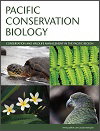PC24086Overfished and under conserved: life-history, ecology and supply chain of the Endangered whitespotted whipray (Maculabatis gerrardi) and sharpnose whipray (Maculabatis macrura) from south-east Asia
 , A. Chin
, A. Chin  , C. Gan, K. Xu-Ting Ting, C. Terence, J. Ng Zheng Kai, D. Wee
, C. Gan, K. Xu-Ting Ting, C. Terence, J. Ng Zheng Kai, D. Wee  and N. Hutchinson
and N. Hutchinson
Whitespotted whipray (Maculabatis gerrardi) and sharpnose whipray (Maculabatis macrura) are caught and traded in large volumes in south-east Asia. This study reveals late maturity (50% age-at-maturity of 5–6 years old), which makes them vulnerable to fisheries. A seafood trader who was interviewed perceives significant population declines.
PC24086 Abstract | PC24086 Full Text | PC24086PDF (1.7 MB) | PC24086Supplementary Material (894 KB) Open Access Article




